|
California Native Plant Society
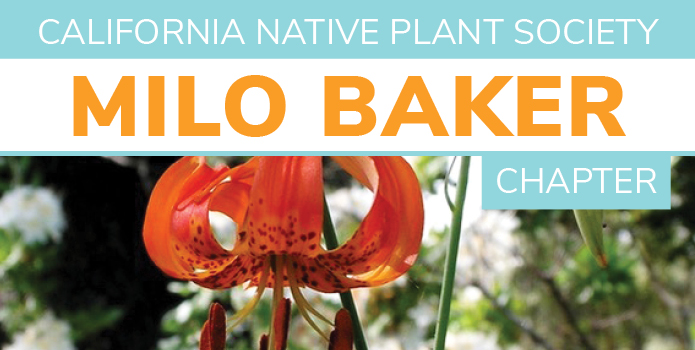 |
May Newsletter
What's in this issue: Speaker Series, New Milo Baker Chapter Website, Eco-Friendly Garden Tour, Plant of the Month, Be on the Lookout for Japanese Knotweed, May Plant Walks, Ongoing Volunteer Opportunities
|
Speaker Series
Third Tuesday of the Month at 7:30 pm
May 16, 2023 (In-person and on Zoom)
Luther Burbank Art and Garden Center, 2050 Yulupa Ave, Santa Rosa, CA 95405
People, Plants and Fire
Trends and cycles over the last 150 years in Sonoma, Lake, and Napa Counties with Arthur Dawson, Historical Ecologist, Founder of Baseline Consulting
Historical ecologist Arthur Dawson will present the findings of a three-year CALFIRE-funded study conducted in partnership with Pepperwood's, Mark Tukman, and Dr. Jim Thorne. Arthur will trace the story of fire and vegetation in the North Bay over the last 150 years. Integrating a wide variety of sources reveals the surprisingly dynamic patterns of chaparral, hardwood, and conifer woodlands in response to wildfire, timber harvest, and wildfire suppression.
It took generations to set the stage for the catastrophic fires of the last decade. It will take several more to change that trajectory. Altering course is going to require hard work on the ground guided by a deeper understanding of the relationship of fire, vegetation and the role of human beings in the landscape.
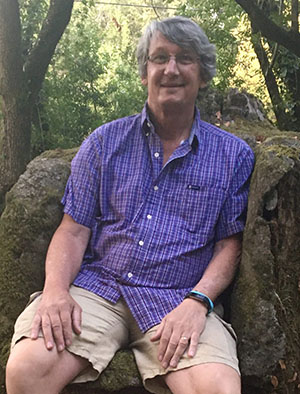 Bio: Arthur Dawson enjoys exploring the local landscape through science and art. As an historical ecologist he has collected oral histories from local elders and contributed field and archival research to regional restoration efforts. His unique approach integrates fieldwork, oral histories, and archival research to tell the story of places and people at every scale, from small parcels to entire watersheds. Bio: Arthur Dawson enjoys exploring the local landscape through science and art. As an historical ecologist he has collected oral histories from local elders and contributed field and archival research to regional restoration efforts. His unique approach integrates fieldwork, oral histories, and archival research to tell the story of places and people at every scale, from small parcels to entire watersheds.
An independent consultant, Arthur has worked with the Sonoma Land Trust, Sonoma County Agricultural Preservation and Open Space District, Pepperwood Preserve, CALFIRE, the Sonoma County Water Agency, UC Berkeley, and many other agencies, organizations and individuals.
As a writer, Arthur has published several articles in scientific journals and written three local bestselling books: The Stories Behind Sonoma Valley Place Names, On Foot in Sonoma (with Rebecca Lawton) and most recently, Where the World Begins: Sonoma Mountain Stories and Images. He has also published a book of poems through Finishing Line Press, Saying this Place Right. His column on Sonoma County place names appears monthly in the Press-Democrat.
Arthur lives with his wife Jill in Glen Ellen.
You can find the Zoom link for this presentation at our website here
We are resuming the before meeting dinners at the Kirin Restaurant, 2700 Yulupa Ave, Santa Rosa. We will meet there at 5:45 pm. Please contact Liz Parsons (707) 508-8345 if you plan to go.
|
New Milo Baker CNPS Website
– June Stephens, Milo Baker Newsletter Editor
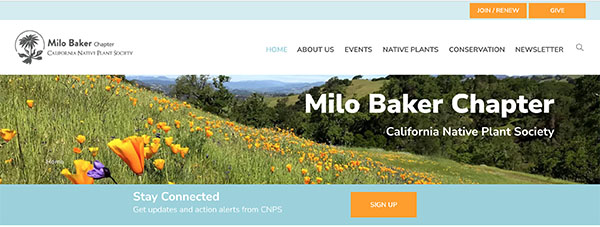
We are announcing the launch of the new Milo Baker CNPS website! The impetus for the change was CNPS’s decision to discontinue support for the Joomla platform that the old site was built on. Web support has now moved to Wordpress, which is used for CNPS’s own website, as well as many of the updated chapter sites. You may notice the recurrent use of templates and page elements that gives all of the CNPS sites a common branding and stronger web presence.
Importantly, the URL of the website has changed. The new URL is: https://chapters.cnps.org/milobaker/. CNPS will put in place an automatic redirect from the old URL to the new one, in the next week or so, however the redirect will not be implemented long-term so all old bookmarks and links should be updated.
Please take a look at the new website: https://chapters.cnps.org/milobaker/. Content from the old site has been migrated to the new site, but may be organized in a slightly different format. The Milo Baker Chapter website remains a work in progress and member input is welcome. Comments may be sent to: cnpsmilobakerwebsite@gmail.com
|
Eco-Friendly Garden Tour
– Betty Young, Milo Baker Nursery Chair
The 2023 Eco-Friendly Garden Tour will take place on Saturday, May 13th, 2023 from 10am - 4pm. The tour will feature eco-friendly gardens throughout Sonoma and Marin counties.

This year's tour will be back to in-person, the first time since 2019! The gardens on the tour this year will be native focused and highlight the importance of landscaping with plants adaptable to our changing climates. A few of the events scheduled at the gardens on this year's tour include; a California Native Plant Society plant sale, free compost pick-up provided by Zero Waste, and informational tables hosted by the Master Gardeners and Garden Sense programs.
Registration is now available. Registration is required, but the event is FREE! Make sure to register and put a reminder on your calendar. We will continue to send out updates, as we get closer to the tour. Share with family and friends as the tour provides a great opportunity to be outside, see beautiful gardens, get inspiration and visit with other gardening neighbors.
Oh, did we mention that the tour is on Mother's Day weekend and we will have a plant sale at our nursery at the Laguna Environmental Center, 900 Sanford Rd, Santa Rosa. A list of plants available at our nursery is available here.
|
Plant of the Month
Ceanothus – the California Lilac
– Liz Parsons, Milo Baker Vice President
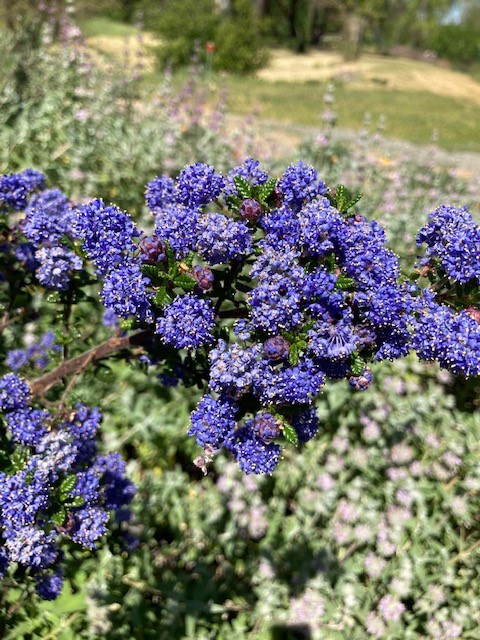 It may seem foolhardy to address the huge Ceanothus complex in a short article. However, here is a very rudimentary treatment, with emphasis on the horticultural varieties. The Ceanothus genus is in the Rhamnaceae family and is divided into two subgenera, the Ceanothus and the Cerastes. This is an important distinction. Plants in the Ceanothus subgenus have round to linear leaves with smooth margins and an alternate branching pattern. They require more water and deer seem to like the fleshier leaves. Ceanothus foliosus, wavy-leaved, and C. thyrsiflorus are members of this subgenus. Plants in the Cerastes subgenus have conspicuously toothed, holly-like leaves with a thick, leathery texture. The branches and leaves are oppositely arranged. Ceanothus sonomensis, C. maritimus and C. confusus (Rincon Ridge Ceanothus) are members of the Cerastes subgenus. Plants in this section are the most drought tolerant and deer resistant. It may seem foolhardy to address the huge Ceanothus complex in a short article. However, here is a very rudimentary treatment, with emphasis on the horticultural varieties. The Ceanothus genus is in the Rhamnaceae family and is divided into two subgenera, the Ceanothus and the Cerastes. This is an important distinction. Plants in the Ceanothus subgenus have round to linear leaves with smooth margins and an alternate branching pattern. They require more water and deer seem to like the fleshier leaves. Ceanothus foliosus, wavy-leaved, and C. thyrsiflorus are members of this subgenus. Plants in the Cerastes subgenus have conspicuously toothed, holly-like leaves with a thick, leathery texture. The branches and leaves are oppositely arranged. Ceanothus sonomensis, C. maritimus and C. confusus (Rincon Ridge Ceanothus) are members of the Cerastes subgenus. Plants in this section are the most drought tolerant and deer resistant.
Early pioneers, with an understandable longing for familiar plants, graced it with the common name, California lilac, referring to the spring blooming panicle of small, blue flowers. (Aside: there are exceptions to all Ceanothus generalizations, the first is that some species have white flowers.) You can plant these evergreen shrubs as a shrubby groundcover, as a foundation planting, as a hedge, as a small tree, or as part of a shrub border.
As we would expect from plants that are native to the chaparral regions of the state, Ceanothus are drought tolerant, hence their value in California gardens. Ceanothus have a reputation for being short lived. This is often a problem of poor placement and poor management. Although, in my experience, they do not live as long as manzanitas and other native shrubs. They require good drainage and are short-lived in wet clay soils where too much water on their roots invite fungus diseases such as root rot. Ceanothus grow rapidly to their ultimate size. Prune in the warm months for rapid healing. Regulate the size by pinching out new shoots, rather than waiting until they are out of control and require radical surgery.
The modern cultivars that are sold in nurseries have proved to do well in our gardens and some will adjust to regular garden watering. Here is a brief introduction to some of those that are available:
Groundcover types are Ceanothus gloriosus var. ‘Emily Brown’, ‘Heart’s Desire’, and ‘Anchor Bay’ (Cerastes). Other selections from the Cerastes subgenus are Ceanothus maritimus ‘Point Sierra’ and ‘Valley Violet’. C. hearstiorum and C. griseus horizontalis ‘Carmel Creeper’ and ‘Yankee Point’(Ceanothus). These will grow to cover an area of about 5 feet.
Mid-size shrubs that grow between 6’ to 8’ are C. impressus ‘Julia Phelps’ and ‘Dark Star’ which both bloom with brilliant cobalt blue flowers. Watch for them now, they are hard to miss! Other mid-size cultivars are C. ‘Concha’ and ‘Joyce Coulter’, and C. thyrsiflorus ‘Skylark’. All of these are in the Ceanothus subgenus.
A very large shrub is C. arboreus, a native to the Channel Islands; in the trade one usually finds C. arboreus x griseus ‘Ray Hartman’. C arboreus ‘Cliff Schmidt’ is available at Cal Flora Nursery. Both can be trained to be a small (15’) evergreen tree or grown as a large shrub. C. thyrsiflorus commonly called blue blossom, is native to the Coast Ranges and can grow to 20 feet. Inland it appreciates some shade, which will moderate the growth. Two C. thyrsiflorus varieties available are ‘Oregon Mist’ and ‘Snow Flurry’ which has masses of white flowers.
There are many other cultivars available. Check the Cal Flora Nursery website or visit their nursery in Fulton. The new Jepson (2012) lists 46 species and numerous sub-species that are found growing in California, so one can spend quite a bit of time getting to know this fascinating shrub group. There is a Timber Press book devoted to them by Fross and Wilkins published in 2006. The Sunset Garden Book has good information on the most common cultivars. If you enjoy old Fremontias, as I do, you will find information on the species origin of many cultivars in the January 1994 issue. The January 1987 issue has an article by Nevin Smith on cultivating Ceanothus.
I hope that I have piqued your interest with this brief account. Remember as you visit gardens and nurseries this spring to keep an eye out for blooming Ceanothus, and perhaps you might buy one or two. The best way to find out about any plant is to grow it in your garden.
|
Be on the lookout for Japanese Knotweed
– Alynn Kjeldsen, Milo Baker Invasive Plant Co-Chair
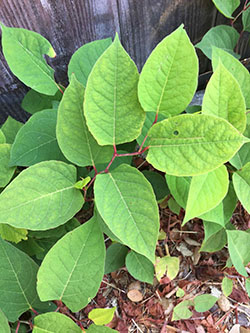 “Native to Japan, China, and Korea, Japanese knotweed (Fallopia japonica) is considered the 10th most invasive plant species in the world, and is considered an A-rated noxious weed by the California Department of Food and Agriculture. This fast-growing member of the buckwheat family forms tall, dense, leafy monocultures that shade out other plants. Supported by a deep and extensive underground rhizome network, it readily resprouts from as little as seven grams of plant material, making it extremely difficult to eradicate. Knotweed is hardy enough to survive on the slopes of active volcanoes and strong enough to penetrate concrete, making it a threat to both natural and developed areas. “Native to Japan, China, and Korea, Japanese knotweed (Fallopia japonica) is considered the 10th most invasive plant species in the world, and is considered an A-rated noxious weed by the California Department of Food and Agriculture. This fast-growing member of the buckwheat family forms tall, dense, leafy monocultures that shade out other plants. Supported by a deep and extensive underground rhizome network, it readily resprouts from as little as seven grams of plant material, making it extremely difficult to eradicate. Knotweed is hardy enough to survive on the slopes of active volcanoes and strong enough to penetrate concrete, making it a threat to both natural and developed areas.
Although Japanese knotweed is not widespread in California, it is found at a number of sites in Marin County. Roughly a third of the known populations are on National Park Service land in Lagunitas Creek, and the others are upstream at Samuel P. Taylor State Park and on private land in San Geronimo Valley.
Knotweed can spread through human disturbance or by water, and has replaced the creekside tree community in other locations with conditions similar to Lagunitas Creek. Without the shade of these trees, water temperatures increase and the insects and debris that help feed these systems diminishes. Changes like this along Lagunitas Creek would have dramatic effects on its wildlife, including endangered coho salmon and threatened steelhead trout.”
While no major infestations have been identified in natural areas in Sonoma County, Calflora has several records of it in Santa Rosa and a few in rural areas near Green Valley Road and Austin Creek Road. These rural areas should be surveyed and monitored as Early Detection and Rapid Response is extremely valuable in situations like this with a new invasive species.
Please visit the Calfora website for excellent pictures to help ID the plant and there are links to further descriptions. And please keep your eye out for Japanese knotweed, record it in Calflora, and contact the appropriate public agency if found on public lands. If you have it in your garden or know someone that has it, take action quick. Herbicide (glyphosate) is extremely effective as rhizomes can grow deep and wide. Cutting and covering with a thick tarp can also be effective for small infestations. Any material that is cut or dug from the plant must be bagged and disposed of in the garbage! Do not compost. No matter the method of removal, the site should be monitored for at least two years to ensure eradication.
Sources: nps.gov, usda.gov, ucanr.edu. Photo credit: 2021 Margo Cunningham (Calflora)
|
May Plant Walks
Monday May 1, 1:00-4:00
Wildflowers of Jenner Headlands Preserve
Leaders: Ruthie Saia, Certified California Naturalist
Click here to register
Monday May 8, 11:00-3:30
Porterfield Creek Open Space Preserve
Leader: Rosaleen Murphy, Certified California Naturalist
Click here to register
Monday May 15, 11:00-4:00
Modini Mayacamas Preserve
Leader: Botanist Peter Warner
Click here to register
For more details about our plant walks please check our website.
To sign up for email alerts contact Milobakerevents@gmail.com
Ruthie Saia, Milo Baker Plant Walk Coordinator
|
Ongoing Volunteer Opportunities
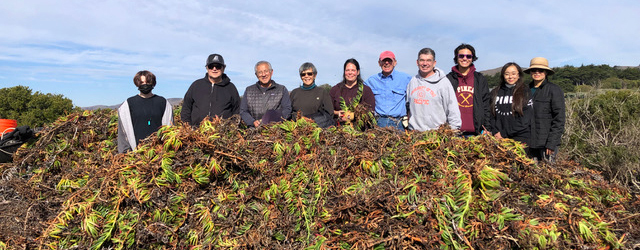
This is a photo of the Kiwanis group that came out to Doran Beach on 11/11 to pull ice plant. They were fantastic and had members of the high school club with them as well. They have cleared over 1000 sq. ft.!!!
Living Learning Landscapes Workday – second Friday of the month (9:30 am - noon). Meet at 1808 Albany Drive in Santa Rosa. Please RSVP to April Owens aprilleeowens@gmail.com so we know to expect you!
Weekly Doran Beach Ice Plant Removal – every Wednesday (9:30 am - 11:30 am). Meet at 9:30 at the Cypress Day Use parking lot, west end. Bring clippers and gloves and knee pads if you like. One of the most pleasant workdays happens every week – a trip to Doran Beach to pull ice plant. We are clearing out the ice plant that is in the marshland to make room for natives. It is very visual and quite satisfying, with the sound of the waves, birds and foghorn.
Bodega Head Ice Plant Removal Project – second Sunday of each month (10:00 am - 1:00 pm). CNPS is leading volunteers at Bodega Head to save native species from getting smothered by ice plant. Meet at the main parking lot near the bathrooms. Bring water, clippers and gloves if you have them. Email Alynn at alynnkjeldsen@gmail.com for more information and to let us know that you are coming.
For more information, please visit the Volunteer Opportunities page on our website.
|
|
|

|
|
|
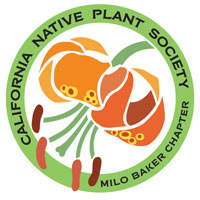
|
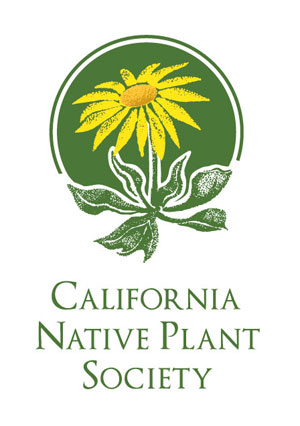
|
|



 Bio: Arthur Dawson enjoys exploring the local landscape through science and art. As an historical ecologist he has collected oral histories from local elders and contributed field and archival research to regional restoration efforts. His unique approach integrates fieldwork, oral histories, and archival research to tell the story of places and people at every scale, from small parcels to entire watersheds.
Bio: Arthur Dawson enjoys exploring the local landscape through science and art. As an historical ecologist he has collected oral histories from local elders and contributed field and archival research to regional restoration efforts. His unique approach integrates fieldwork, oral histories, and archival research to tell the story of places and people at every scale, from small parcels to entire watersheds.

 It may seem foolhardy to address the huge Ceanothus complex in a short article. However, here is a very rudimentary treatment, with emphasis on the horticultural varieties. The Ceanothus genus is in the Rhamnaceae family and is divided into two subgenera, the Ceanothus and the Cerastes. This is an important distinction. Plants in the Ceanothus subgenus have round to linear leaves with smooth margins and an alternate branching pattern. They require more water and deer seem to like the fleshier leaves. Ceanothus foliosus, wavy-leaved, and C. thyrsiflorus are members of this subgenus. Plants in the Cerastes subgenus have conspicuously toothed, holly-like leaves with a thick, leathery texture. The branches and leaves are oppositely arranged. Ceanothus sonomensis, C. maritimus and C. confusus (Rincon Ridge Ceanothus) are members of the Cerastes subgenus. Plants in this section are the most drought tolerant and deer resistant.
It may seem foolhardy to address the huge Ceanothus complex in a short article. However, here is a very rudimentary treatment, with emphasis on the horticultural varieties. The Ceanothus genus is in the Rhamnaceae family and is divided into two subgenera, the Ceanothus and the Cerastes. This is an important distinction. Plants in the Ceanothus subgenus have round to linear leaves with smooth margins and an alternate branching pattern. They require more water and deer seem to like the fleshier leaves. Ceanothus foliosus, wavy-leaved, and C. thyrsiflorus are members of this subgenus. Plants in the Cerastes subgenus have conspicuously toothed, holly-like leaves with a thick, leathery texture. The branches and leaves are oppositely arranged. Ceanothus sonomensis, C. maritimus and C. confusus (Rincon Ridge Ceanothus) are members of the Cerastes subgenus. Plants in this section are the most drought tolerant and deer resistant. “Native to Japan, China, and Korea,
“Native to Japan, China, and Korea, 
